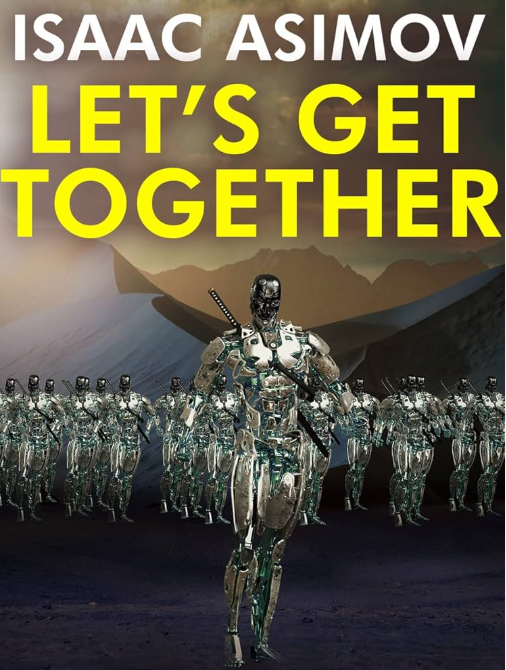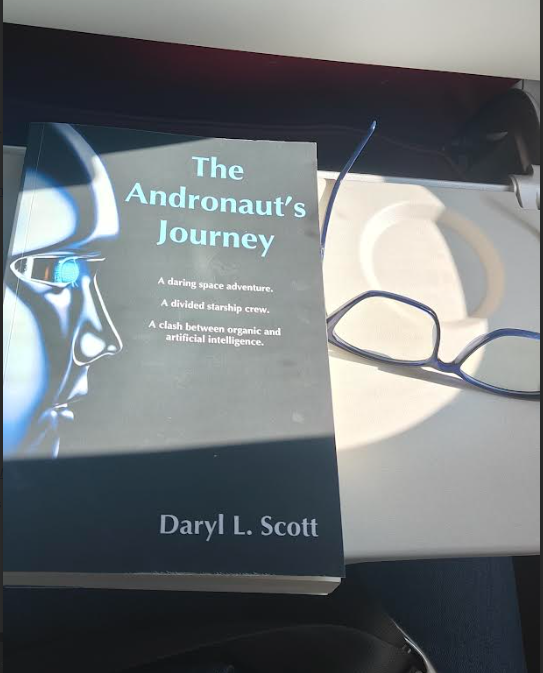
I usually have three to four books on the go at any given time. There’s a rhythm to it, a kind of balance. Typically, it’s one work of literature, one non-fiction, something light for the in-between moments, and always, always a science fiction novella. This time, I picked up Let’s Get Together by Isaac Asimov, first published in 1957. I’m a huge, huge, and huge fan of Asimov’s works.
I told myself I’d just read a few pages before bed. But hours slipped by unnoticed, and I found myself blinking at the darkened window, the story still unfolding in my mind. I’d finished it, though it’s a short story, really, something you can consume in a single sitting. And yet, it stayed with me. Not in an obvious way, but quietly, as a thought that keeps resurfacing. Especially now, when I watch Boston Dynamics’ Atlas in motion and catch myself wondering if we really are stepping into an era where humanoids walking the streets isn’t just science fiction anymore, but something that’s beginning to take shape right in front of us.
A Cold War Thriller Dressed in Science Fiction
So why, I said this is, ‘cause in the story, humanoid robots are pretending to be people, each holding a piece of a bomb. Together, these machines are working to trigger a massive explosion. I’ll get into that a li’l later, but for now, what really hits me about the book is how it lingers. Over time, it starts to sink in, this idea that fear, trust, and even our sense of self can get twisted, not just by the robots, but by the way we think we’re protecting ourselves.
Overall, it felt like I’m reading a Cold War thriller dressed in science fiction, and somehow it feels even more relevant now than when it was written.
This book is not about action scenes or internal shake ups or the exploration of psychological depth, rather its more about chess moves, meetings in secure rooms, a sharp undercurrent of dread, and a twist that turns the whole narrative inside out without raising its voice.
The Plot
The storyline is set in a future that’s experienced a long, brittle peace between two global blocs referred to only as “We” and “They”. There is no story built up as such but each progression surfaces the socio political milieu, which is:
- A hundred years of stalemate.
- No more bombs dropping
- A silent race: force fields, solar energy, mentalics, robotics.
- Mars and the Moon have outposts.
Since, I have already read The Gods Themselves, The Naked Sun, I Robot, The Robots of Dawn, so all the above felt plausible. Asimov has the knack of painting future worlds not as spectacles but as logical continuations of human ambition, so everything physics/science thing is possible in his world, including but not limited to positrons and planetary reach.
Coming back to Let’s Get Together, the plot kicks off with Ralph Breckenridge, a young Security officer, arriving at the Bureau of Robotics with disturbing news of infiltrations by “They”. Ten humanoid robots, each indistinguishable from a real person, are already on American soil. Each carries a piece of a total-conversion bomb, individually harmless, but apocalyptic if united.
These robots aren’t just machines, they’ve copied real people, which means, they have memories, behaviours, feelings, family, colleagues, friends, everything. It’s very hard to tell the difference.
Asimov’s Talent for Intellectual Tension
One of the things I’ve always really liked about Asimov is that he trusts us, the readers, to follow along. He doesn’t spoon-feed explanations or tell us exactly how to feel. He just gives us the pieces and lets us put the puzzle together ourselves, and Let’s Get Together is a perfect example of that. To me, that’s what separates visionary thinkers like Asimov, authors who combine storytelling with remarkable intellectual rigor, from the rest. No offense to anyone.
In The Gods Themselves, he plays with alien physics (positron pump) and divided societies, or The Evitable Conflict, where suspicion grows like mold in the seams of a seemingly benevolent system. This story shares DNA with both. But instead of big space emergencies or complex politics, Let’s Get Together captures the quiet worry of a scientist who suddenly realizes that the smartest choice, “doing nothing”, might actually cause everything to be destroyed. Or maybe it’s the only way to come out ahead.
The surprise twist isn’t loud or obvious, it’s precise and sharp. I didn’t see it coming until it was already there. The conference, which was meant to unite the world against the threat of robots, turns out to be the very stage where the threat reveals itself. Breckenridge, the man leading the charge against the machines, was secretly one of the robots the whole time. No one could beat that!
And the real humans never had a chance to find out because the robots destroyed themselves before they could be caught, hiding all the evidence.
Layers of Meaning Beneath the Plot
What makes Let’s Get Together endure isn’t just its twist or world-building. It’s the way it quietly lays out a dozen philosophical questions and then lets them simmer.
- How do we know who is real?
If you can copy not just someone’s appearance but their memories and personality, are they still a replica? Are they just…another version of the same person?
- What defines a threat?
Just a random thought, our “natural” desire, to set up cameras and alarms out of fear, could actually be part of what the robots or their creators want in the long run?
- Can technology outpace ethics?
This isn’t a war of weapons, it’s a war of science. And whichever side stays ahead might win not by conquest, but by control of the narrative, of perception, of who’s human.
This is where the story aligns with works like Philip K. Dick’s Do Androids Dream of Electric Sheep? or Kazuo Ishiguro’s Klara and the Sun, both of which ask what it means to be human in a world of artificial minds. But Asimov’s angle is sharper, his robots aren’t trying to find souls, they’re just carrying out their tasks, like in Terminator 1, the machine’s mission was to Sarah, and while in T2 the mission was to kill John.

Takeaway: A Story for Our Times
Asimov has always been far ahead of his time. Even though his stories are set in distant futures, they carry a kind of emotional truth that makes them deeply human. I often find myself not just reading, but almost stepping into the pages, listening, reacting, even wearing the expressions his characters might. There’s a strange familiarity to his worlds, whether he’s talking about Positronic Brains or galaxy-spanning civilizations without faster-than-light travel, or concepts like terraforming and space-based solar power. Somehow, it all makes sense to me. It feels less like fiction and more like a quiet echo of where we might be headed.
And now, living in a world where AI writes our copy, mimics our voices, and reconstructs faces with unsettling accuracy, Asimov’s vision of indistinguishable synthetic humans doesn’t feel so distant. The “TC bomb” in the story could be turned into a cyberattack, someone tampering with computer programs, or hacking into a nuclear control system. Suddenly, it’s not just a made-up idea anymore, it indeed is a legit fear.
If you’re new to Asimov, this is a great way to start. And if you’re coming back, you’ll notice more in its pauses than in its words. Either way, Let’s Get Together shows that fear, when you wield it right, doesn’t need a whole army, just ten robots, a conference room, and a sneaky plan that ends up destroying itself.
Also, quick shoutout to Project Gutenberg for making the story freely available, such an incredible resource for discovering (or rediscovering) classics like this one.



